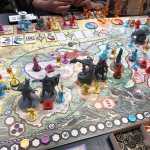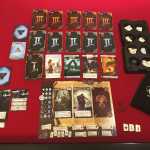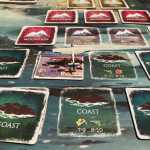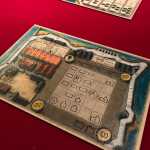Review: Azul: Stained Glass of Sintra

Azul was a huge success and surprise in 2017. No one really saw it coming, but its bakelite pieces captured our hearts and minds with its simple concept, streamlined mechanics, and hidden depth. So when we heard that designer Michael Kiesling was putting out a "sequel" of sorts, we had to try it. As we gave it a whirl, Azul: Stained Glass of Sintra also surprised us, but left us with a different kind of wonder than Azul did.
Gameplay

to destroy myself!
In Azul: Stained Glass of Sintra (which we'll refer henceforth as Sintra, because forget typing all that nonsense every time), the basic tile-drawing mechanics are similar to Azul, but different. Instead of automatically drawing a tiles of one color and pushing the others to the middle (as in Azul), you get a choice: either go with the tile mechanic, or move your "glazier" all the way to the left. This glazier fellow is a cute little meeple that is far more nefarious than he first appears. He drastically affects your game, as you cannot place tiles to the left of him at all. This means your carefully devised plans will likely end at some point with "oh crap I can't place there yet", with the maniacal laughter of your glazier taunting you again and again...

Just don't throw stones.
When drawing tiles, you'll place them on any column space (or "window") below or to the right of the glazier that matches the color of the tiles you drew. It's pretty simple but maddeningly deep, as when you place those tiles, you must move the glazier above the window you place on. This limits your future movements, as now you have less windows to place on (unless you sacrifice a turn to move the glazier back). You'll want to optimize the order you place tiles in so as to not waste turns moving the glazier around unnecessarily.
Unfortunately, your opponents are doing the same, and you're still fighting that familiar Azul feeling of trying to get the tiles of a certain color before they do - even if you may not have the best place to put them yet. This leaves you having to make less great choices a lot in Sintra, even moreso than its predecessor.
Tiles you can't place (either by having too many or nowhere to place) don't fall to the bottom like Azul - they simply move a counter on the scoring board down that will give you an increasingly larger number of negative points at game end. Unless, of course, you do this a lot, and hit the horrible -18 point space, where you immediately lose -18 points and reset said counter. Brutal.

One thing that they did fix with Azul is you get the "Glass Tower" - a simple box-like structure that discarded tiles go to which makes pouring them back into the draw bag so much easier than the box top Azul prescribed. I cannot tell you the amount of times I spilled tiles all over the table trying to pour them in Azul; the tower is a nice improvement. However, the tiles are a bit of a disappointment. I couldn't shake the feeling like I was looking at Jolly Rancher candies the entire game.
Scoring
Scoring is similar to Azul, in that you score when you've filled a column. You slide down any tile from the completed window to a scoring marker below. It's a bit easy to forget the mechanics here - at the bottom of the board are numbers (increasing from 1-4 as you go left, and a 2 on the far right) that tell you how much you score when you complete that window. However, you'll also score points for every window to the right of that window you've completed at least once as well, so finishing painting all the right columns before you do the left ones can get your some great multipliers late-game. That is, if you can finish them.

if snaky
Finishing a column will, the first time you do it, flip it to the other side, which presents a different color set to complete. After finishing it the second time, you'll simply remove the window from your board, giving you less placement options as you go.
The game ends after 6 rounds. Each round, there's a scoring color that will also net you bonuses if you fill a window with tiles of that color. Oh, and did I mention there's an A side and B side to your scoring board? One will give you points end-game for completing windows in clusters of 2x2; the other will - in a pure brain-burner - have you multiply the number of windows you've "finished" (filled twice) by the number of tiles of any color you select that you slid down into the scoring position of that window.
The latter really changes the strategy of the game, so that - combined with randomized columns every game - give Sintra a lot of replayability.
Thoughts
I really want to like Sintra - there's a lot of depth here, and the Glazier mechanic is fantastic. The choices feel consequential, defensive play has a lot more weight, and the increased reliance on tactical play due to a higher RNG element gives it a nice replay value.

But still, I can't shake the feeling that so much of the game feels tacked on. Unlike Azul, where the game design seemed stripped down to its bare necessities until it felt pristine, Sintra seems to be a base mechanic with a whole bunch of stuff added later to make it feel "complete". Azul is just far more streamlined, and Sintra feels a lot more like a great idea still searching for the right path to take it where it wants to go. Don't get me wrong, that doesn't make it a bad game - Sintra is a great game that could easily compete with a whole host of other abstract titles - but it could probably have done without a few things in its package.
If you have Azul, you probably don't need Sintra. If you love abstract tile-laying games, this is a good game for your collection, but I personally won't own both. For a more complex play, Sagrada might fit your niche a bit more than Sintra does. But as for sophomore releases of a genre, Sintra is still an excellent addition to the board game universe. If this is a preview of the future of the Azul universe to come, I for one welcome our colorful tile masters with open arms.
Pros
Fairly simple premise with lots of depth
Increased depth adds interesting decisions
Glazier mechanic is great
Feels like Azul yet totally different
Cons
Some scoring mechanisms seem lazily bolted on
Pieces of lower quality than expected
Increased randomness is a blessing and a curse
great
Board game reviews and news from Austin, Texas. We provide no-nonsense reviews about all kinds of games. With flair.





